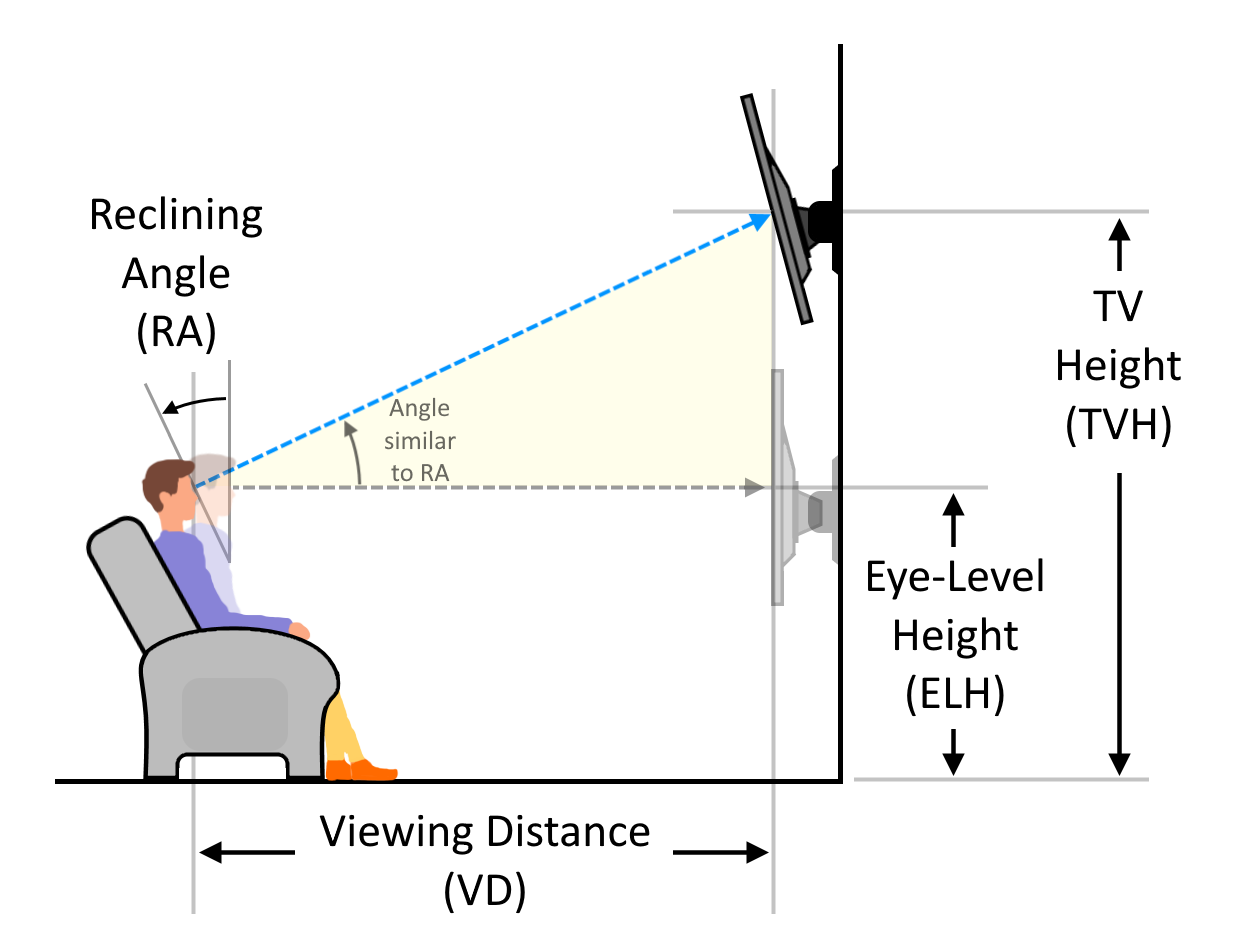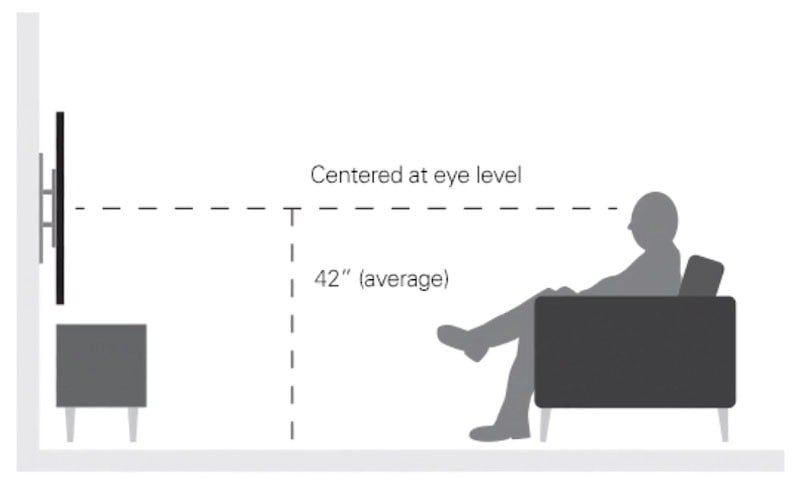Factors Influencing Ideal TV Height: Optimum Height For Wall Mounted Tv In Bedroom

Finding the perfect height for your wall-mounted TV is crucial for an enjoyable viewing experience. The ideal height is not a one-size-fits-all solution, as several factors come into play. This section delves into these factors, helping you determine the optimal position for your TV in your bedroom.
Viewer’s Seated Height
The most important factor in determining the ideal TV height is the viewer’s seated height. The goal is to achieve a comfortable viewing angle, minimizing neck strain and maximizing visual comfort.
- Optimal Viewing Angle: The recommended viewing angle for a TV is between 30 and 40 degrees. This means that the center of the TV screen should be at or slightly below eye level when seated.
- Calculating Ideal Height: To calculate the ideal TV height, you can use a simple formula:
(Seated Height x 0.85) – (TV Height / 2) = Ideal TV Height
For example, if your seated height is 36 inches, and your TV is 40 inches tall, the ideal TV height would be approximately 27 inches from the floor.
TV Screen Size
The size of your TV screen significantly impacts the ideal mounting height. Larger screens generally require a higher mounting position to maintain a comfortable viewing angle.
- Maintaining Proportion: A larger TV screen at a lower height can lead to an awkward viewing experience, as the bottom of the screen might be too close to the floor.
- Example: For a 55-inch TV, the recommended mounting height might be higher than for a 40-inch TV, even if the viewers have the same seated height.
Furniture Placement and Room Layout, Optimum height for wall mounted tv in bedroom
The placement of your furniture and the overall room layout also play a role in determining the ideal TV height.
- Furniture Arrangement: Consider the distance between your seating area and the TV wall. If the distance is short, a lower mounting height might be suitable. Conversely, a longer distance may require a higher mounting height to maintain the ideal viewing angle.
- Room Layout: The room’s layout can also influence TV height. For example, if you have a fireplace or a large window on the wall opposite the TV, you might need to adjust the mounting height to avoid glare or obstructions.
Ergonomic Considerations
Ergonomics play a crucial role in creating a comfortable and enjoyable viewing experience.
- Neck Strain: A TV mounted too high can cause neck strain as you constantly look upwards. Conversely, a TV mounted too low can lead to neck strain as you look downwards.
- Eye Fatigue: A TV mounted at an incorrect height can also lead to eye fatigue. The ideal height minimizes eye strain and allows you to focus comfortably on the screen.
Safety Considerations
Incorrect TV mounting height can pose safety risks, particularly for children and pets.
- Children: A TV mounted too low might be within reach of children, increasing the risk of accidental damage or injury.
- Pets: A TV mounted too low might be tempting for pets to jump on or scratch, potentially damaging the screen or causing injury.
General Guidelines for Wall Mounting TV in Bedroom

Determining the ideal height for your wall-mounted TV in the bedroom is crucial for an enjoyable viewing experience. This involves considering factors like your seating distance, screen size, and personal preferences. By following these guidelines, you can create a comfortable and visually appealing setup.
Calculating Optimal TV Height
The optimal TV height is typically based on the viewing distance and screen size. The goal is to position the center of the TV screen at or slightly below eye level when seated. This minimizes neck strain and promotes a comfortable viewing experience.
The general rule of thumb is to position the center of the TV screen approximately 1.5 to 2 times the height of the screen above the floor.
For instance, if you have a 55-inch TV and are sitting 10 feet away, the center of the screen should be roughly 35 to 45 inches above the floor. This height ensures that you can view the screen comfortably without straining your neck.
Recommended TV Heights for Different Screen Sizes and Room Layouts
The following table provides recommended TV heights for various screen sizes and room layouts, assuming a standard seating distance of 8 to 10 feet:
| Screen Size (inches) | Recommended TV Height (inches) |
|—|—|
| 40 | 30-35 |
| 43 | 32-37 |
| 49 | 36-41 |
| 55 | 40-45 |
| 65 | 46-51 |
| 75 | 54-59 |
These are general recommendations, and you can adjust the height based on your individual preferences and seating arrangements.
Tips for Achieving Balanced and Aesthetic TV Placement
To achieve a balanced and aesthetically pleasing TV placement in your bedroom, consider these tips:
- Consider the focal point: The TV should be the focal point of the room, but it shouldn’t dominate the space. If you have other furniture or décor elements, ensure the TV complements them without clashing.
- Maintain symmetry: If possible, position the TV in the center of the wall or above a symmetrical piece of furniture, like a fireplace or a media console. This creates a visually balanced look.
- Avoid clutter: Ensure the area surrounding the TV is clutter-free. Clutter can distract from the viewing experience and create an unorganized feel.
- Choose the right mounting bracket: Invest in a high-quality mounting bracket that allows for tilt and swivel adjustments. This enables you to fine-tune the TV’s position for optimal viewing angles.
- Blend with the surroundings: Consider the overall style of your bedroom when choosing a TV stand or mounting bracket. The TV should blend seamlessly with the existing décor.
Benefits and Drawbacks of Mounting the TV Above a Fireplace
Mounting a TV above a fireplace can be a stylish and practical solution, but it comes with its own set of benefits and drawbacks:
- Benefits:
- Aesthetic appeal: A TV mounted above a fireplace can create a visually appealing focal point in the room.
- Space-saving: This setup eliminates the need for a separate TV stand, maximizing floor space.
- Convenience: The TV is positioned at eye level when seated on a sofa or chair in front of the fireplace.
- Drawbacks:
- Heat exposure: The TV can be exposed to excessive heat from the fireplace, potentially affecting its performance and lifespan.
- Viewing angle: The TV might be too high for comfortable viewing, especially if the fireplace is large or the ceiling is low.
- Safety concerns: Mounting the TV above a fireplace requires careful planning and installation to ensure it’s securely mounted and doesn’t pose a fire hazard.
Additional Considerations for Bedroom TV Mounting

Beyond the ideal height and general guidelines, several factors can significantly influence your TV mounting experience in the bedroom. These considerations go beyond just placement and ensure a comfortable and enjoyable viewing experience.
Lighting Conditions and Glare
The amount of natural light entering your bedroom can significantly impact the viewing experience. Direct sunlight can create glare on the screen, making it difficult to see the picture clearly. To minimize glare, consider the following strategies:
- Window Treatments: Utilize curtains or blinds to control the amount of sunlight entering the room. Blackout curtains are particularly effective at blocking out all light.
- TV Placement: Position the TV away from windows or sources of direct sunlight. If possible, mount the TV on a wall that doesn’t receive direct sunlight during peak hours.
- Anti-Glare Screens: Consider using an anti-glare screen for your TV. These screens are designed to reduce reflections and improve visibility in bright environments.
Cable Management
A cluttered mess of cables can detract from the overall aesthetics of your bedroom. Proper cable management is essential for maintaining a neat and organized appearance.
- Cable Ties and Organizers: Utilize cable ties, clips, and organizers to bundle and secure cables behind the TV. This keeps them out of sight and prevents them from becoming tangled.
- Concealed Wiring: If possible, consider running cables through the walls or behind baseboards to hide them completely. This requires some DIY skills or professional assistance.
- Wireless Connections: Opt for wireless connections whenever possible, such as Bluetooth speakers or streaming devices, to reduce the number of cables.
Wall Type and Construction
The type of wall in your bedroom can impact the mounting process. Different wall materials have varying load-bearing capacities, which is crucial for securely mounting a TV.
- Drywall: Common in many homes, drywall requires special mounting techniques to ensure stability. Using drywall anchors or toggles is essential for supporting the weight of the TV.
- Concrete or Brick: These walls are typically very strong but require specialized drill bits and mounting hardware. It’s advisable to consult with a professional for assistance with mounting on these surfaces.
- Stud Location: Before mounting the TV, locate the wall studs for maximum support. Using a stud finder can help you identify the best mounting points for stability.
Selecting the Right Mounting Bracket
Choosing the appropriate mounting bracket is crucial for both safety and functionality. Consider these factors when selecting a bracket:
- TV Size and Weight: Ensure the bracket can support the weight of your TV. Check the bracket’s weight capacity before purchasing.
- Tilt and Swivel Features: Some brackets offer tilt and swivel capabilities, allowing you to adjust the TV angle for optimal viewing.
- VESA Compatibility: The VESA standard refers to the mounting hole pattern on the back of the TV. Ensure the bracket you choose is compatible with your TV’s VESA pattern.
Optimum height for wall mounted tv in bedroom – Finding the perfect height for your wall-mounted TV in the bedroom is key for optimal viewing comfort. Consider the height of your bed and the overall layout of the room to determine the best placement. A soothing backdrop for your TV can be achieved with white dove bedroom walls , creating a serene ambiance that complements the viewing experience.
By adjusting the height of your TV, you can ensure that your bedroom is a relaxing sanctuary for both sleep and entertainment.
Finding the perfect height for your wall-mounted TV in the bedroom is crucial for comfortable viewing. While the ideal position varies based on individual preferences and seating arrangements, a good starting point is to align the center of the screen with eye level when seated.
This ensures a relaxed viewing experience, preventing neck strain. To complement the modern feel of your TV, consider incorporating French country bedroom wall decor for a touch of warmth and charm. This rustic aesthetic can beautifully contrast with the sleekness of your TV, creating a harmonious and inviting ambiance in your bedroom.